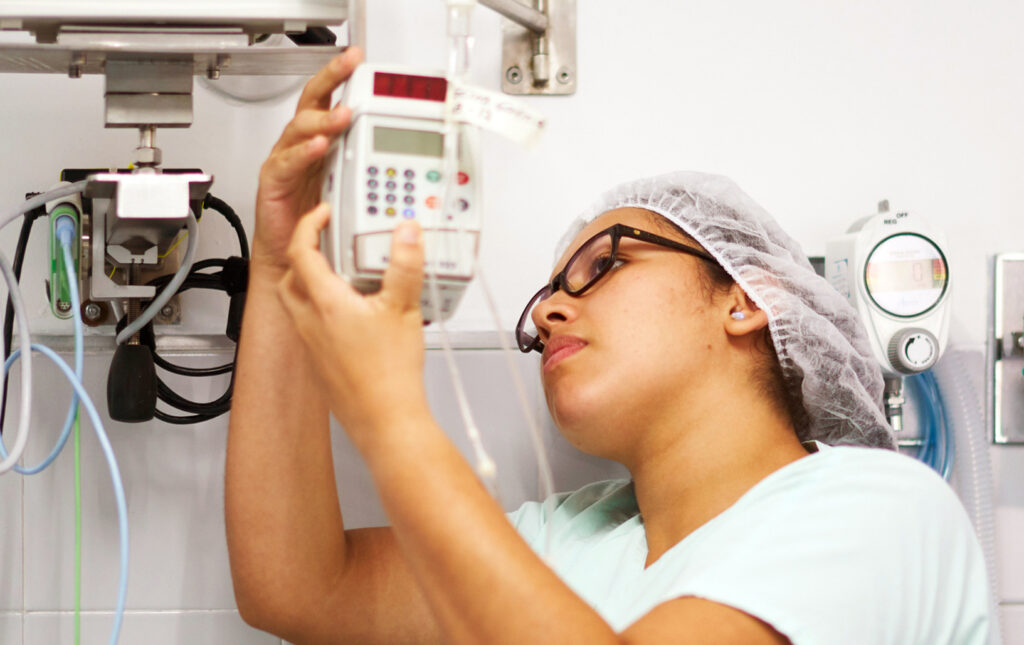SUMMARY
Enovacom’s vision
At the heart of the future of digital health, a fundamental mission has guided our commitment at Enovacom since 2002: interoperability of health information systems.
We believe that the future of the health sector depends on seamless collaboration among multiple stakeholders, and it is precisely this vision that has shaped our expertise for over 20 years. Enovacom has always been at the forefront of innovation in health information systems. Our mission is to remove barriers that hinder communication between the different links of the care chain to maximize the effectiveness of health institutions and improve care quality.
Interoperability is not simply a technical concept. For us, this is the key to a new era of collaboration between healthcare professionals, healthcare facilities, researchers and, most importantly, patients.
We believe that every piece of medical information, every test result, and every interaction between sector stakeholders should be accessible and easily and securely shared to provide a global and comprehensive view of every individual’s health.
Why did we choose to make interoperability the pillar of our expertise? Because we understand that fragmented hospital information systems (HIS) are major impediments to operational efficiency and the delivery of quality care.
We believe that interoperability is not just an asset, but a necessity to address the complex challenges the health sector faces today.
Enovacom is committed to being your trusted partner in building a future where the interoperability of health information systems is not only an option, but the cornerstone of a connected and resilient health system.
What is health data interoperability?
What is interoperability, and how does it benefit the entire hospital’s care and administration teams? Making health data interoperable involves having various applications of an information system talk to each other. This enables separate software solutions to exchange data, no matter what their format.
By allowing multiple solutions to communicate with each other, interoperability helps manage information efficiently and appropriately. In contrast, a closed or proprietary system, which is not interoperable, prevents a seamless exchange due to a lack of common protocols.

There are several types of interoperability, including:
- “Technical” interoperability, which is the interconnection between two systems. This interoperability is based on the use of defined interfaces, standards and shared protocols that meet the security and confidentiality requirements of personal health data.
For example: the HL7 standard (Health Level Seven) for health data exchange. - “Semantic” interoperability, which is based on interoperability repositories, allows two systems to use a common language (words and syntax) to produce and exploit exchanged health data. Businesses develop value-added services on these semantic and syntactic bases by retracing the data (e.g., time evolution curve, decision support, automatic processing of natural language, artificial intelligence).
For example: SNOMED CT for the anatomical localization description. - “Syntactic” interoperability, which transforms meaning into symbols, allows the machine to recognize the nature, type and format of the information exchanged, and requires an open exchange system.
For example: XML, JSON, or HTML syntax to understand and translate data.
As healthcare institutions modernize and put interoperability at the heart of their information system strategy, IT managers must no longer connect each application point to point. When a data exchange flow is established for each application connection, an incomprehensible tangle is systematically created.
Today, data exported from one application to another goes through the interoperability platform to match the expected language. Such a tool has become essential to the policy of simplifying a HIS. It is the foundation of health institutions’ modern architecture.
Everything goes through the information system
A HIS can have up to seven hundred software systems in its architecture. This number varies depending on the structure’s size. These are all solutions that need to connect to each other so that they can communicate or at least integrate with the HIS.
The HIS has two main missions.
- Administrative and financial management:
The HIS enables the complete management of patients from admission to discharge and supports prescription or billing. It also manages inventory (such as orders and supplies). Moreover, it is responsible for the hospital’s activities, including planning, room management and certain human resources responsibilities, such as access to hospital services via a badge. - Care management:
From a medical perspective, the HIS facilitates care by integrating the data into the Electronic Patient Record (or EHR) or pulling it up from medical devices. The HIS is also at the heart of the hospital’s external data exchanges, as it enables communication with the external care stakeholders.
Which interoperability platform for which uses?
The lack of a healthcare organization’s interoperability can lead to the establishment of information silos. This makes it difficult to use and share information between services and institutions.
Two types of interoperability platforms often used in the HIS can overcome this problem:
- Enterprise Application Integration (EAI) platforms support internal data exchange between different departments through interconnection between different departments and feeding the computerized patient record, etc.
- External Data Interchange (EDI) platforms exchange electronic data with external healthcare partners such as laboratories, blood banks and other care providers.
EAI platforms enable data exchange between information systems using standardized interfaces. They are frequently used to integrate third-party applications into the HIS, enabling different systems to communicate and exchange data in real time.
EAIs can also facilitate collaboration between health institutions, enabling data sharing between networks and information systems. They specifically manage both internal and external hospital flows.
EDIs, on the other hand, allow greater flexibility in data exchange. They are responsible for securely sending documents outside the HIS, such as moving them to a national computerized care record or sending these documents via secure health messaging.
EDIs often make managing clinical, administrative, and financial data easier, and improve the quality of care by enabling better coordination between hospital departments and partners.
The differences between EAI and EDI are therefore related to their respective functions. EAIs are primarily focused on the exchange of data between different information systems, while EDIs focus on flow interoperability, helping collect, aggregate, and transform data according to the health institution’s needs.
Both platforms are complementary and can work together to provide a global interoperability solution.
HL7 FHIR: a standard to simplify data exchange
The interoperability standard HL7 format has evolved over the years. To democratize its use and implementation, the format has opened to current web practices (HTML, XML, JSON).
The FHIR standard now broadens possibilities with its library of open source resources.
Enhancing health data means making it easily and quickly accessible. FHIR addresses this need for accessibility by becoming more agile than previous interoperability standards. This new standard, used to store and exchange data in a JSON format, results in standardized, patient-focused data modelling.
This model is based on data that maps from multiple information systems, such as computerized patient records and administrative patient management.
It therefore illustrates the relational model of information systems in healthcare and will be the same no matter how the data consumer uses it. FHIR uses modular components called resources, available in open source, to standardize the data’s structure in a single model. Each resource will then contain the data that characterizes it.
Interoperability as a foundation for healthcare professionals’ day-to-day use
All the solutions created to improve health data management and facilitate the work of professionals share a common foundation: interoperability.
The EDI platform is essential for secure health messaging, as it ensures that the various messaging proxies used by health institutions are interoperable. The platform will enable healthcare professionals to communicate easily, even using different information systems.
The same applies to biomedical interoperability, which helps healthcare professionals access patient biomedical data (lab results, medical images, etc.) quickly and efficiently.
Interoperability will connect the entire medical device fleet to the HIS for easy uploading of data into care records, thus avoiding the need to re-enter the information generated by monitoring devices. Not only does it save caregivers time, but it also guarantees the institution’s identity management.
Enovacom Patient Connect: biomedical interoperability to connect all medical devices to your information system
Enovacom Data Repository – the FHIR data warehouse to enhance your data
Interoperability will also ensure the storage and use of health data in a data warehouse. For this solution to be effective, it is essential that data sources are interoperable to feed the warehouse. This will allow the data collected from all the software in the HIS to be aggregated, analyzed and used.
Using data health sources daily will revolutionize how healthcare professionals care for patients. The possibility of accessing data already stored in the information system will enable caregivers to anticipate the development of a disease or conduct clinical research in their field.
Health data interoperability is a key area for improving the quality of patient care. By simplifying data exchange between caregivers and patients, the latter become part of their own care.
Whether you can book an appointment or find your medical data in a secure space, interoperability significantly improves all stages of the patient care experience.
As information and communication technologies evolve, patients have access to more tools to manage their health, such as smartphone applications. The same is true for health institutions that use the same tools to facilitate appointment scheduling or provide guidance on follow-up care. With the interoperability of health data, patient applications can connect with other HIS software to facilitate the flow of information between patients and their caregivers.




